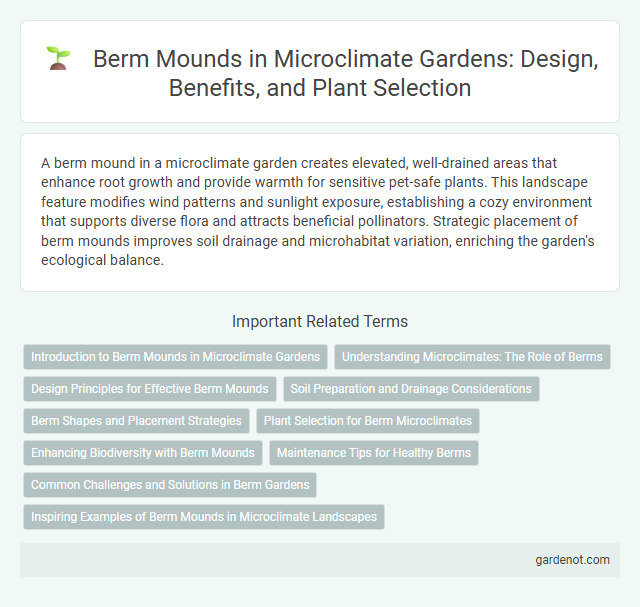A berm mound in a microclimate garden creates elevated, well-drained areas that enhance root growth and provide warmth for sensitive pet-safe plants. This landscape feature modifies wind patterns and sunlight exposure, establishing a cozy environment that supports diverse flora and attracts beneficial pollinators. Strategic placement of berm mounds improves soil drainage and microhabitat variation, enriching the garden's ecological balance.
Introduction to Berm Mounds in Microclimate Gardens
Berm mounds in microclimate gardens create elevated soil structures that modify wind patterns, sunlight exposure, and drainage to foster plant growth. These raised earth formations enhance thermal regulation by absorbing heat during the day and releasing it at night, benefiting sensitive plants. Strategically placed berms optimize microclimatic conditions, improving resilience and productivity within garden ecosystems.
Understanding Microclimates: The Role of Berms
Berm mounds play a crucial role in shaping microclimates by altering wind patterns, sunlight exposure, and moisture retention within a garden space. Their elevation and soil composition create warm, sheltered areas that support diverse plant growth and protect delicate species from harsh environmental conditions. Integrating berms strategically enhances microclimate variability, promoting biodiversity and improving garden resilience.
Design Principles for Effective Berm Mounds
Effective berm mound design in microclimate gardens incorporates strategic shaping to maximize sunlight exposure and wind protection for sensitive plants. The use of varied heights and gentle slopes promotes efficient water drainage and soil retention, enhancing plant health and reducing erosion. Integrating native vegetation and organic mulch further stabilizes the berm while fostering biodiversity and microhabitat diversity within the garden.
Soil Preparation and Drainage Considerations
Berm mounds in a microclimate garden require well-aerated, nutrient-rich soil with organic matter to enhance moisture retention and root growth. Proper soil preparation involves loosening compacted layers and incorporating compost to improve structure and fertility. Drainage considerations include ensuring the berm's base has adequate slope and possibly installing gravel or sand layers to prevent waterlogging and maintain optimal soil moisture levels.
Berm Shapes and Placement Strategies
Berm mound design in microclimate gardens significantly influences water drainage, sun exposure, and wind protection, optimizing plant growth conditions. Popular berm shapes include crescent, horseshoe, and circular, each strategically placed to maximize moisture retention and create microclimate zones tailored to specific plant needs. Placement strategies prioritize south-facing slopes in northern hemispheres to harness solar gain while serving as windbreaks to reduce wind stress on sensitive vegetation.
Plant Selection for Berm Microclimates
Selecting plants for berm microclimates involves prioritizing species that thrive in well-drained, elevated conditions with varying sun exposure levels. Drought-tolerant perennials such as Sedum, Lavender, and Salvia are ideal for sunnier berm slopes, while shade-tolerant ferns and hostas suit lower or north-facing areas. Incorporating native grasses and deep-rooted shrubs enhances soil stability and supports diverse microhabitats within the berm garden ecosystem.
Enhancing Biodiversity with Berm Mounds
Berm mounds create varied microhabitats that support diverse plant species and attract beneficial insects, birds, and small mammals, enhancing overall ecosystem biodiversity. Their elevation improves soil drainage and temperature regulation, fostering unique plant communities often absent in flat garden areas. Incorporating berm mounds effectively increases habitat complexity and promotes a resilient, thriving microclimate garden.
Maintenance Tips for Healthy Berms
Regularly inspect berm mounds for erosion and compacted soil, ensuring proper drainage to prevent waterlogging or runoff damage. Mulching with organic materials like wood chips helps retain moisture and suppress weeds, reducing maintenance efforts. Prune vegetation strategically to promote healthy growth and avoid overcrowding, which can impair airflow and increase susceptibility to pests.
Common Challenges and Solutions in Berm Gardens
Berm mounds in microclimate gardens often face challenges such as soil erosion, poor water retention, and nutrient depletion. To combat these issues, incorporating organic mulch and planting deep-rooted native vegetation improves soil stability and moisture retention. Installing drip irrigation systems and using compost amendments further enhance plant health and promote sustainable growth on berms.
Inspiring Examples of Berm Mounds in Microclimate Landscapes
Berm mounds in microclimate gardens create elevated, sun-exposed zones that support diverse plant species and improve water drainage. Famous examples like the Xeriscape Berm in Albuquerque optimize heat retention and wind protection, fostering drought-resistant plants and enhancing habitat biodiversity. These berms demonstrate how contouring landscapes can modify microclimates to sustain resilient ecosystems in arid environments.
Berm mound Infographic

 gardenot.com
gardenot.com